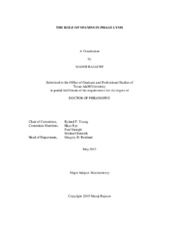| dc.description.abstract | The work described in this dissertation addresses how spanins function during phage lysis, focusing on the 2CS system of phage lambda, in which Rz and Rz1 are the prototype i-spanin (inner membrane subunit) and o-spanin (OM lipoprotein subunits) of the spanin complex.
Results obtained from genetic and biochemical approaches found that there must be at least one homodimerizing intermolecular disulfide bond near the heterotypic interface. The covalent linkage of spanin homodimers was found to be mediated by the host Dsb system, the first time that this system has been shown to catalyze the formation of intermolecular disulfide bonds. Genetic and biochemical studies with the paradigm phage T4 revealed striking differences in the requirements for position and disulfide bond formation in the PseT.3/PseT.2 2CS system, presumably reflecting the separated architecture of the T4 spanin genes.
Mutational analysis using an extensive collection of Rz and Rz1 mutants highlighted important domains and motifs of Rz and Rz1 that are required for function. A method has been developed to isolate intragenic and intergenic suppressors for these mutants, which should allow future studies to interrogate interacting interface between the different domains of spanin subunits.
In addition, it was found that the spanin complex, in the absence of holin function, can cause rapid lysis of a host mutant that is compromised for peptidoglycan biosynthesis, suggesting that spanin function is regulated by the meshwork of intact peptidoglycan. Furthermore, we developed a spheroplast method to test the model proposed for spanin function: that the last step of lysis is fusion between the IM and OM. The method is based on the fusogenic properties of the spanin subunits externalized on the outer surface of the cytoplasmic membranes of spheroplasts. The unambiguous result was that the lambda 2CS subunits supported efficient, spheroplast fusion, and that spanin missense mutations that abrogate lysis in vivo also blocked the spheroplast fusion activity. These results suggest the last step in lysis of the Gram-negative host is OM disruption by fusion with the IM. | en |


